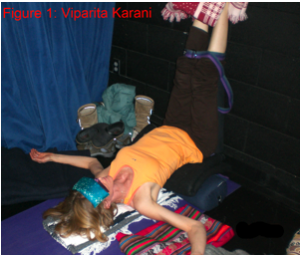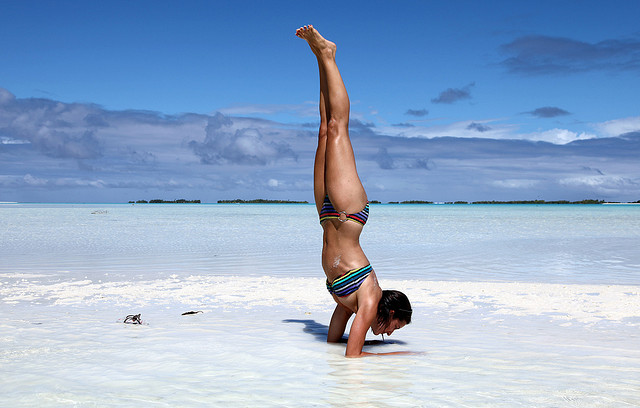Part 1: Inversions bring on whole new perspective!
If you find yourself falling out of inversions more than you are falling IN LOVE with inversions, you’re definitely not alone! I’ve coached hundreds of students through headstands, handstands, and shoulder stands to where I understand some of the common pit “falls” of inversions and am here to help.
Before you get all “I’m just not cut out for upside down balancing” on me, I’ll let you in on a secret…Inversions are simpler than you think. That’s right. You could be reaping the benefits of inversions already and not even realize your good fortune. Let’s break it down…
An inversion in its simplest definition is any posture where your head is lower than your heart. With that in mind, a standing forward bend (AKA Uttanasana) and downward facing dog can be placed in the same category as headstands, shoulder stands, and handstands, making inversions accessible to nearly everyone. And there’s more good news!
Your pose doesn’t have to look like the model on the cover of Yoga Journal to produce the same benefits.There are many variations to support you.
 For instance, standing forward bends can be a challenge for some of us in the “I just don’t bend like I used to” category. If this sounds like you, then you may enjoy a seated forward bend or a standing ½ downward facing dog using the wall as support.
For instance, standing forward bends can be a challenge for some of us in the “I just don’t bend like I used to” category. If this sounds like you, then you may enjoy a seated forward bend or a standing ½ downward facing dog using the wall as support.
Props can enhance the experience and get you deeper in the pose when done with skillful instruction. All props are acceptable: walls, chairs, blocks, bolsters, straps, etc. Modifications to shoulder stand using the wall as in “Legs-up-the-wall” pose or Viparita Karani (see Figure 1) has the same effect as shoulder stand but less stressful on the neck and shoulders. The benefits of inversions are plenty, with little risk when practiced with awareness, proper props and gentle warm-up postures.
According to Yoga Journal some of the benefits include:
- Calming the brain and helping to relieve stress and mild depression
- Stimulating to the thyroid and prostate glands and abdominal organs (shoulder stand)
- Stretching the shoulders and neck (shoulder stand)
- Toning the legs and buttocks
- Improved digestion
- Helping relieve the symptoms of menopause
- Reducing fatigue and alleviates insomnia
- Therapeutic for asthma, infertility, and sinusitis
- Stimulating the pituitary and pineal glands (Head stand)
- Strengthening to the arms, legs, and spine (Head stand, downward facing dog)
- Toning the abdominal organs (Head stand)
- Strengthening the lungs
Just because a head stand isn’t something you are integrating into your yoga practice today, there are plenty of options that will allow you to reap the health benefits NOW by creatively including inversions into your daily practice.
If inversions have still got you down, join us for Advanced Yoga Group Classes where we delve into more advanced yoga practices like inversions. Also, be sure to check out Are You Falling for Inversions Yet Part 2!

